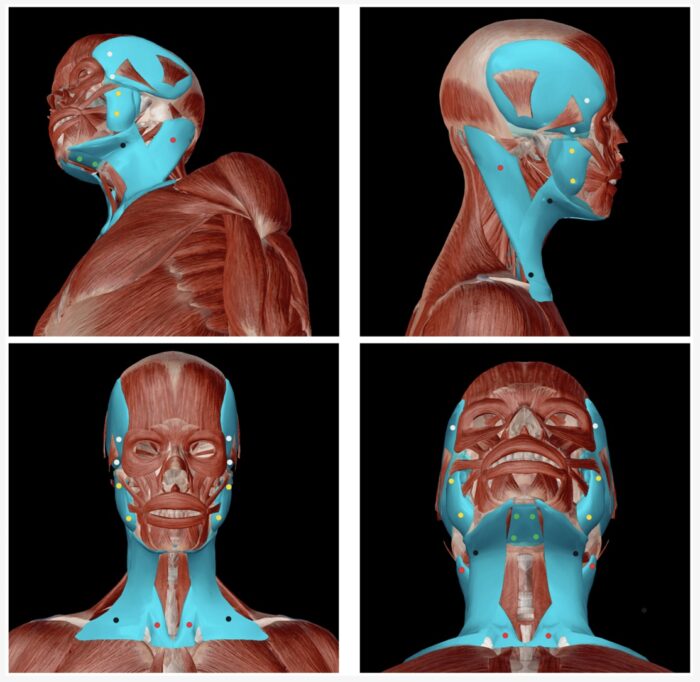Publications

Dynamic Correlations and Disorder in the Masticatory Musculature Network
Authors: Gaetano Campi 1, Alessandro Ricci 2, Nicola Costa 3, Federico Genovesi 4, Jacopo Junio Valerio Branca 5, Ferdinando Paternostro 5, Daniele Della Posta 3
Affiliations:
- Institute of Crystallography, CNR, Via Salaria Km 29.300, 00015 Monterotondo, Italy
- Duferco Corporate Innovation, Via Trevano 2A, 6900 Lugano, Switzerland
- The Anatomical Network APS, Via Fermo 2c, 00182 Rome, Italy
- Manchester City Football Club, Manchester M11 3FF, UK
- Department of Experimental and Clinical Medicine, Anatomy and Histology Section, University of Florence, 50134 Florence, Italy
Journal: Life - October 2023, Volume 13, Issue 11, Article no. 2107 (DOI: 10.3390/life13112107)
-
Field & Applications:
- Medical
- Musculoskeletal disorder
- Temporomandibular disorder
- Orofacial muscles
- A significant objective of this research study is to introduce the MyotonPRO as an innovative tool in the domain of functional masticatory diagnostics.
- The joint utilization of the anatomical network model and the MyotonPRO represents an advanced approach to obtaining a comprehensive and detailed assessment of muscle function, with a specific focus on patients afflicted by temporomandibular disorders (TMDs) or other chewing-related conditions.
Background: Temporomandibular joint (TMJ) disorders, which affect millions of people worldwide, have multiple etiological factors that make an accurate diagnosis and effective treatments difficult. As a consequence, the gold standard diagnostic criteria for TMJ disorders remain elusive and often depend on subjective decisions.
Aim: In this context, the lack of a non-invasive quantitative methodology capable of assessing the functional physiological state and, consequently, identifying risk indicators for the early diagnosis of TMJ disorders must be tackled and resolved.
Methodology: In this work, we have studied the biomechanics and viscoelastic properties of the functional masticatory system by a non-invasive approach involving 52 healthy subjects, analysed by statistical-physics analysis applied to myotonic measurements on specific points of the masticatory system designing a TMJ network composed of 17 nodes and 20 links.
Results: We find that the muscle tone and viscoelasticity of a specific cycle linking frontal, temporal, and mandibular nodes of the network play a prominent role in the physiological functionality of the system. At the same time, the functional state is characterised by a landscape of nearly degenerated levels of elasticity in all links of the network, making this parameter critically distributed and deviating from normal behaviour.
Conclusions: Time evolution and dynamic correlations between biomechanics and viscoelastic parameters measured on the different cycles of the network provide a quantitative framework associated with the functional state of the masticatory system. Our results are expected to contribute to enriching the taxonomy of this system, primarily based on clinical observations, patient symptoms, and expert consensus.

Figure 1. Muscle taken into consideration for measurement with the use of MyotonPRO. The coloured points show the 20 points where measurements have been taken by MyotonPRO on each subject.
Keywords: temporomandibular joint disorder, graph theory, dynamic correlations, stable distributions
In summary, we have defined a quantitative evolutive trend of the functional TMJ system based on statistical-physics modelling of myotonic measurements performed on 52 healthy patients. Our modelling highlights the importance of the first cycle in the functionality of the masticatory system and the critical nature of the decrement parameter. Additionally, it provides an understanding of the system’s dynamics and the correlations between the different measured parameters. This model could offer deeper insights into the understanding and classification of temporomandibular disorders by investigating the extent of deviation from the physiological trend in measurements performed in non-healthy patients.
Indeed, the taxonomy of the temporomandibular joint (TMJ) is primarily based on clinical observations, patient symptoms, and expert consensus. Thus, a significant gap exists in this taxonomy due to the absence of a physical-mathematical model. Despite the complexity of TMJ disorders, involving biological, psychological, and social factors, we believe that methodologies based on quantitative models could significantly enhance the current taxonomy and contribute positively to this field, improving the diagnosis and treatment of muscular disorders in the masticatory region.


